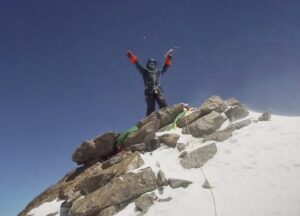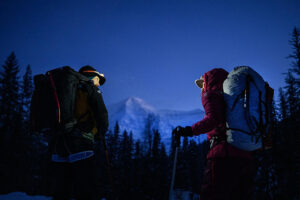The first ascent of Latok IV is a tale of exploration, commitment, iron will, solidarity, and a dose of the surreal.
The Latok group
The Latok group is a set of steep rock peaks in the Panmah Muztagh, a sub-range of the Karakorum, east of the Ogre group. Impressive peaks of extreme technical difficulty: Only the best climbers in the world are capable of reaching their summits. The first ascents of Latok I, II, and III all took place in 1979.
Latok IV (6,456m) is the last mountain in its group and has a crest of four peaks. The main summit is the North Peak, and the secondary summit is to the southeast, only marginally lower at 6,450m.
In 1976, a Japanese attempt on Latok IV ended with the death of a climber.

Latok IV. Photo: Jiri Pliska/Ondrej Mandula
The 1980 Sangaku Doshikai expedition
In the summer of 1980, Japan’s Sangaku Doshikai expedition set out to climb Latok IV. The group consisted of Koji Okano, Hisashi Handa, Tsutomu Tagusari, Motomu Omiya, and expedition lead Dr. Masaki Noda.
On July 4, they established Base Camp on the Baintha Lukpar Glacier at 4,600m. The following day, they began to climb. Three days later they had reached Camp 2, below the southwest face. On July 9, they tried to climb the face alpine-style. They bivouacked at 6,005m, but the next day was tough going. Half of the group were too tired to climb, only Handa and Omiya continued. It got late, and they had to stop just 45m from the top. They retreated back down to their bivouac, and from there, to Base Camp.
The second attempt
A few days later, on July 15, Handa, Omiya, and Okano ascended again. Handa turned around, but Okano and Omiya reached the main 6,456m peak at 8:45 am on July 18. Before descending, Omiya climbed to the southern summit as well. It was surely a sweet moment for both climbers. Perhaps they were murmuring “wabi-sabi”, a Japanese philosophy that centers on the beauty of imperfection and how ephemeral perfection is.

Latok IV. Japanese Route, 1980: red line (1). Photo: Jiri Pliska/Ondrej Mandula
The accident
They started to descend but the weather soured. At around 5,800m, it started to snow heavily. Quickly, they started digging a hole to bivouac.
“It seemed to me [that there was] a hole through which the snow was falling…but I looked up at the sky and saw that the weather was getting worse and worse…so we kept digging,” Omiya later explained. Alas, the snow blanket they were digging into was only 50cm thick. Below that yawned a 45m deep crevasse. In an instant, the two Japanese climbers fell into the abyss.
About nine kilometres away, unknown to Omiya and Okana, a three-man British group was exploring as well. Cairns Dickson, Victor Saunders, and Will Tapsfield intended to climb the 6,422m virgin peak, Uzum Brakk. The team was setting up Base Camp on the Biafo Glacier, studying potential routes, cooking, and drinking tea. Dickson was the team leader, a botanist turned professor who never took off his tie, even on the glacier. Tapsfield was a doctor and Saunders, the only one with a climbing permit, a London architect.

The Biafo Glacier. Photo: Yousaf Feroz Gil
After falling into the crevasse, Omiya lost consciousness for 24 hours. He had broken his leg and several ribs. Okano was conscious but had suffered three broken ribs. When he tried to move, he only fell further, worsening his injuries.
Omiya eventually regained consciousness. He saw blood everywhere. His tibia had broken through the skin, and he was in excruciating pain. “I decided to escape alone. I remembered that the crevasse was a ridge-like projection in the face and began to dig horizontally in the snow wall,” he said.
It took three days for Omiya to make a 3.5m horizontal tunnel. Four days after the fall, he emerged from the crack. But he was far from safe. He was missing a boot and a crampon on one foot and had to bivouac, without food and without a sleeping bag, with his gruesomely broken leg little more than dead weight. Meanwhile, Okano remained at the bottom of the ice hole, unable to move.
Thinking of Doug Scott
“That night’s bivouac without protection was terrible. I encouraged myself by thinking of Doug Scott crawling on the Ogre,” Omiya said.
He began to descend, without rope and on one foot. From a distance, he saw Camp 2. Unable to scream, he desperately waved his hands to his companions. One climber saw the signal and happily went back into the tent to prepare tea for Okano and Omiya. He had completely misread the signal. It was only when the two didn’t make it to Camp 2 by nightfall that he realized that something was wrong.
The British team was doing a reconnaissance of the area. In the distance, they noticed two men on the glacier. As they approached the two men could be heard shouting: “crack, accident!”
It was the two liaison officers, one from each group, who by some quirk of fate happened to have the same name: Captain Kayani. The British and Japanese teams got to work on a rescue. They managed to lower Omiya to Japanese Camp 1. Saunders, who was now in Camp 1, said he feared the worst when he saw that the others were lowering an inert body towards them. But suddenly, the torso sat up and said politely: “Hello! How do you do?”
Despite his injuries, Omiya began to organize his team. He gave orders, took control down to the smallest detail, and explained where they could find the crevasse and Okano, who had now been imprisoned for eight days.

For Omiya, Scott was the inspiration for his self-rescue. Photo: Doug Scott
A gothic temple and the descent
The British climbers feared that they would find Okano out of his mind and that his reaction might be violent due to a delirious state, injuries, and dehydration. When they reached the crevasse they screamed but there was no response. In his book Elusive Summits, Saunders compares the crevasse to a gothic temple.
They lowered Saunders into the crack. At the bottom, he found Okano semiconscious and in a very bad condition. Saunders tried to comfort Okano, leaning over him he spoke the only Japanese phrase he knew: “Konichiwa, Okano-san, ogenki desu ka?” (How are you Mr. Okano, are you okay?) Okano was horrified. He thought that he was seeing a ghost.
With Okano severely injured, the descent was almost impossible. They had to go through seracs and use jumars. For Okano, everything was very painful, but he stoically repeated “I understand” throughout the descent, occasionally fainting from the pain.
It was a desperate descent but they finally succeeded. Okano and Omiya were then evacuated by helicopter to Gilgit hospital.
After the rescue, the English continued their expedition and managed to climb most of Uzum Brakk, but stopped just short of the summit. However, they knew that the summit was not the most important thing. They had struck up a beautiful friendship with the Japanese team.
After both groups finished their expeditions, the Japanese team doctor went to visit the rescuers in England. He gave them a gift from Okano and Omiya, sent in gratitude for their solidarity on the mountain.

Uzum Brakk. Photo: Jiri Pliska, Ondrej Mandula
Okano survived eight days in the chasm and a very difficult descent.
The British team interrupted their own expedition to help and accepted great danger while lowering a wounded man on dangerous ground.
Omiya never gave up hope of finding Okano alive.
Only later did it emerge that Okano did not speak any English at all! All he could say was “I understand.”






